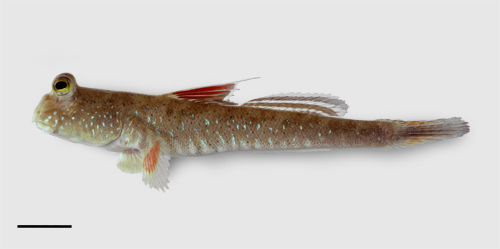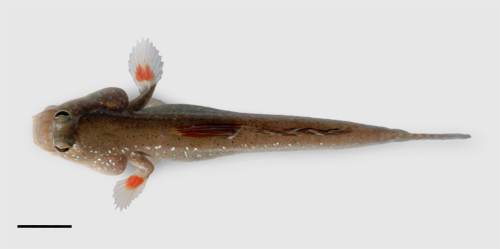Common names:
China |
Chinese Mandarin |
九刺弹涂鱼, 九刺彈塗魚 (jiu ci tan tu yu - nine-spined mudskipper) |
Philippines |
Tagalog |
bia |
India |
English |
Pearse's mudskipper |
Italy |
Italian |
perioftalmo di Pearse* |
Thailand |
Thai |
กะจังตีน, kachangtin |
* proposed name
|
|
|
Synonyms:
Etymology:
'Periophthalmus' is a compound name from the Greek 'peri' (around), and 'ophthalmôn' (eye), which refers to the wide visual field of these species
'novemradiatus' means 'with nine rays' in Latin, which refers to the number of spines in D1
|
Maximum recorded length:
51 mm SL (Jaafar et al., 2009)
Live colouration (Jaafar et al., 2009; Y. Ikebe; pers. obs.: specimens imported from India):
ground colour dorsally and laterally light brown, ventrally whitish to grey; darker saddle-like dorsal blotches extremely variable, from barely visible to dark brown; iridiscent bluish speckles on cheeks, opercula and
flanks, more numerous on head; numerous black speckles smaller than scales scattered on flanks and dorsum; D1 membrane with a transparent background and margin, and with flecks between elements: red in the anterior portion and greyish posteriorly; D2
transparent, except for an inframarginal and a medial dark stripes, both being marginally darker, and dark spots basally between rays; caudal fin membrane transparent to dusky, with rays' proximal portion with series of brownish to orange speckles, medially darker; pectoral fins transparent, with proximal crescent reddish blotches;
anal fin transparent; pelvic fins whitish to dusky
Colouration on preservation (Jaafar et al., 2009;
pers. obs.: Bangladesh, India):
ground colour pale brown dorsally and laterally, whitish to greyish ventrally; darker, irregular and often very faint dorsal saddle
bars; whitish speckles may be visible on head and flanks; dark speckles smaller than scales scattered on flanks usually visible. D1 background and margin transparent, heavily pigmented between spines; D2 background transparent with an inframarginal and a medial dark stripes, and dark spots basally between rays; caudal fin rays brownish, medially darker; anal fin whitish to hyaline; pectoral fins dusky, proximally pigmented; pelvic fins whitish to dusky
Diagnosis (Jaafar et al., 2009):
D1 VIII-X; total elements of D2 12-13;
total elements of anal fin 13-14; longitudinal scale count 62-67; predorsal scales 18-24; length of anal fin base 21.0-24.4%SL; D1 with no spots; D2 with two prominent dark stripes, one located inframarginally and the other one medially, and with basal spots between rays; pelvic fins with prominent frenum and inner rays united by a basal membrane for more than one half of
their length. Sexually dimorphic species: males with greatly elongate first spine of D1, reaching more than half D2 when appressed.
The genus is yet undefined by synapomorphies
Diet:
no published study is available
Reproduction:
the reproductive
cycle of this species have not been described in literature: it probably follows the general model proposed for all
the congeneric species (see also Reproductive behaviour)
|
Ecological notes (Tarikul Islam, pers. comm.: Bangladesh; Y. Ikebe: Thailand):
locally abundant along vegetated creek and river banks, also in low salinity conditions.
middle: Paikgacha upazila (Khulna district), Bangladesh: a typical habitat of
P. novemradiatus (photo: Tariqul Islam, 2003)
|
|
|
Remarks:
Murdy (1989) considered P. variabilis Eggert, 1935 as a junior synonym of P. novemradiatus (Hamilton, 1822). More recently, Jaafar & Larson (2009) restored P. variabilis Eggert, 1935, a species distributed from the Straits of Malacca to the Sulu Sea, and rediagnosed P. novemradiatus. These two species might be sympatric in southern Thailand.
|
A: male of P. novemradiatus, mud bank of a tidally influenced river (photo: Y. Ikebe*; Ranong, Thailand, mudskipperworld); B: ventral view of the pelvic fins: note the basal membrane connecting the inner rays for more than half of their length; C:
lateral view of the dorsal fins; D: another close-up of the dorsal fins and body colouration (photos B, C, and D: J. van Tassell* and Frank Greco*; imported specimen from India, in a tank, 2011) - * with permission
|






